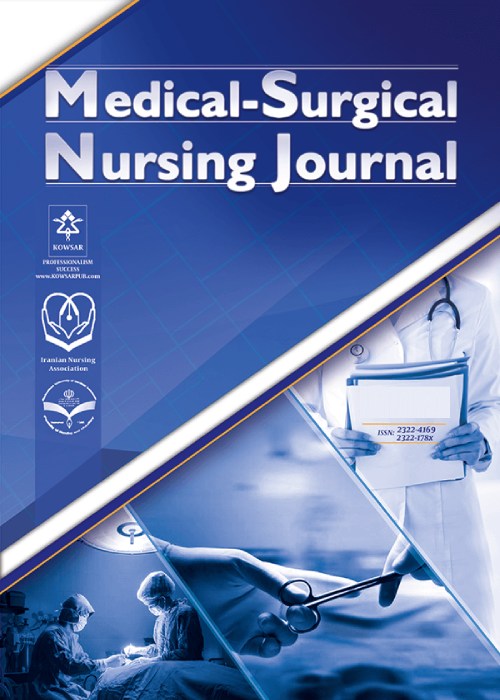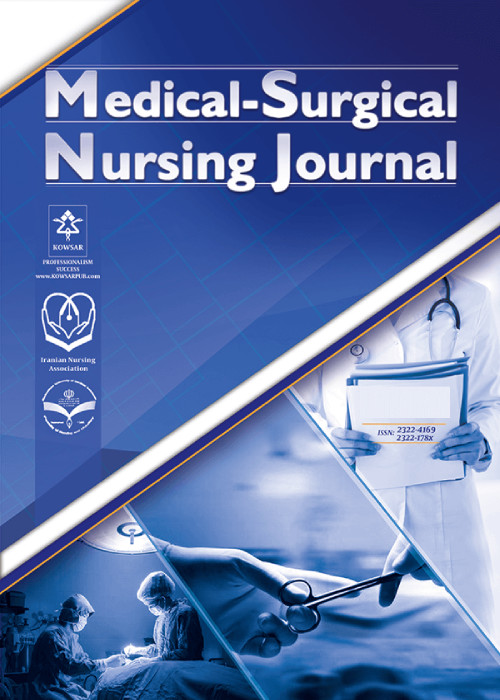فهرست مطالب

Iranian Journal Of Medical - Surgical Nursing
Volume:11 Issue: 4, Nov 2022
- تاریخ انتشار: 1401/09/22
- تعداد عناوین: 6
-
-
Page 1
Context:
This study aimed to provide an overview of cardiopulmonary-cerebral resuscitation (CPCR) training methods for nurses in Iran and introduce some innovations in using training methods to improve nurses’ knowledge and skills in clinical settings. Cardiac arrest is one of the most common causes of death worldwide. Evidence shows that despite the support for improving and treating cardiac arrest in recent years, the overall survival rate after it is still low. Thus, an awareness of the latest CPCR methods is vital for nursing staff. To this end, nurses’ knowledge and skills can be promoted using effective training interventions and techniques.
Evidence Acquisition:
In this review study, the English keywords; education, training, cardiopulmonary-cerebral resuscitation, nurses, knowledge, skill, and performance, and their equivalent Persian terms were searched in articles published from 2010 to 2020 in Iranian and international databases including Google Scholar, SID, IranMedex, Magiran, PubMed, Ensani.ir, and CINAHL. A total of 21 articles were identified. After removing duplicate articles and the studies conducted in Iran, ten articles were selected for the final review.
ResultsIn recent years, different conventional and modern training techniques have been used to teach cardiopulmonary resuscitation (CPR) to nurses in Iran to improve one or two areas of learning (knowledge and performance). The combined use of these training methods can enhance nurses’ knowledge, skills, and satisfaction with CPR training.
ConclusionsThere are many conventional and modern methods for teaching clinical skills. Thus, the most effective methods should be used to teach CPCR to nurses. To this end, educational officials and managers should use integrated training methods to improve nurses’ CPCR skills.
Keywords: Education, Cardiopulmonary-Cerebral Resuscitation, Nurses, Knowledge, Skills, Performance -
Page 2Background
Surgery is one of the most frequent healthcare events worldwide. Individuals have different expectations of surgery. As most adult patients have a family member beside them and the family presence is important, this study was aimed to explain the expectations of the families of patients undergoing surgery.
MethodsThis qualitative study was carried out using the conventional content analysis method. A purposive sample of the family members of patients undergoing surgery was recruited with maximum variation from hospitals in Tehran, Iran, in 2019. The sampling method was purposive sampling. The data were collected through semi-structured interviews. Data collection was continued until the categories were saturated. In total, 29 interviews were conducted with 25 family members, 3 nurses, and 1 surgeon.
ResultsOverall, 29 interviews were conducted. A total of 811 primary codes without overlap, 446 primary codes with overlap, 36 subcategories, and 11 generic categories were extracted. Finally, four main categories were obtained, named endless confusion, giving the family a share in care, exaggerated focus on obvious behaviors, and accepting the existence of the family.
ConclusionsFamilies come apart at the seams. Their expectations and needs might not be met and are usually considered unimportant. They need to be seen, heard, considered, understood, and, most importantly, accepted by healthcare providers, especially nurses.
Keywords: Expectations, Needs, Family, Surgery, Qualitative Research -
Page 3Background
Correct endotracheal tube suction is one of the effective methods to prevent ventilator-associated infection. Many studies have reported that normal saline and N-acetylcysteine (NAC) in the trachea lead the translocation of bacteria to lower levels and increase the risk of pneumonia.
ObjectivesThe present study sought to examine the effect of tracheal suction with NAC on the incidence of ventilator-associated pneumonia (VAP).
MethodsThis single-blind randomized clinical trial study was conducted on 60 patients admitted to the intensive care unit (ICU) of the Khatam Al-Anbia Hospital in Zahedan, Iran, in 2020. The patients were selected using the convenience sampling method and assigned into two intervention and control groups by permutation block randomization. Before the intervention, the patients were evaluated using the Modified Clinical Pulmonary Infection Score (MCPIS), and the patients with scores < 5 on this scale were included in the study. Suctioning tracheal secretions in the intervention group was performed by pouring 2 cc of NAC into the tracheal tube during suction. The same suction procedure was performed for the patients in the control group by pouring 2 cc of normal saline into the tracheal tube in a standard way. The intervention was conducted for five days. After the intervention, the MCPIS scale was administered once more for the two groups. The collected data were analyzed using the independent samples t-test and chi-square test with SPSS software (version 25).
ResultsThe independent samples t-test showed no significant difference between the intervention and control groups regarding the incidence of pneumonia (P = 0.31).
ConclusionsDespite the effect of NAC on the incidence rate of pneumonia in patients under mechanical ventilation, there was no significant difference between NAC and normal saline in reducing the incidence of pneumonia. However, since NAC leads to no specific complication in patients, it can be safely used in the suction of tracheal lobule secretions in patients under ventilators. In this regard, further studies should examine the use of NAC for suctioning during tracheal tube obstruction by secretions.
Keywords: NAC, Endotracheal Suction, Ventilator-associated Pneumonia -
Page 4Background
Premature neonates are a group of high-risk patients who need intensive medical care and hospitalization in the neonatal intensive care unit (NICU) for their survival. In theNICUenvironment, there are highly stressful stimuli that have a negative effect on the physiological parameters of premature neonates. One of the interventions that improve the physiological parameters of neonates is the implementation of the quiet time protocol.
ObjectivesThe present study aimed to investigate the effect of the quiet time protocol intervention on the physiological parameters of premature neonates admitted to the NICU.
MethodsThis quasi-experimental study was performed on 62 premature neonates selected through a convenient sampling method out of the neonates admitted to the NICU. First, the samples of the control group were collected. A demographic data questionnaire was employed. Neonates in the two groups were examined for 60 min during three phases before, during, and after the intervention in the evening shift of 15 - 17 o’clock. Data were analyzed using the SPSS software version 22 by the chi-squared test, repeated measures analysis of variance (ANOVA), and t-test. P-value < 0.05 was considered statistically significant.
ResultsThe results of repeated measures ANOVA regarding arterial blood oxygen saturation (SaO2) percentage showed that changes over time were significant (P < 0.001). There was also a significant difference between the groups in terms of intervention effect (P = 0.004). In other words, the changes in SaO2 percentage were not the same in the two groups, and the changes in the score of the intervention group were higher than the control group. The results of repeated measures ANOVA showed that the changes in the heart rate and respiratory rate over time were significant (P < 0.001).
ConclusionsThe quiet time protocol is effective in reducing environmental stimuli and improving physiological parameters. Therefore, the implementation of these procedures during each 8-hour shift, that includes a specific period which light, sound, and bedside stimulation is controllably reduced, is recommended as a standard of care to reduce stress and improve the growth and development of premature neonates in the NICU.
Keywords: Quiet Time Protocol, Physiological Parameters, Premature Neonates, Neonatal Intensive Care Unit -
Page 5Background
The family’s inability to communicate with a patient with COVID-19 who was admitted to the intensive care unit (ICU) and the lack of information about the patient’s condition greatly affected the anxiety, depression, and uncertainty of family members.
ObjectivesThis study examined the effect of telehealth communication on anxiety, depression, and visits by family members of COVID-19 patients admitted to ICUs.
MethodsThis quasi-experimental study was performed on 60 family members of COVID-19 patients admitted to ICUs of medical centers affiliated with Zahedan University of Medical Sciences in 2021. The participants were selected using convenience sampling and randomly divided into intervention and control groups. In the intervention group, the patient’s condition, changes in the patient’s consciousness level, diagnostic and therapeutic measures, and the care received was reported daily for 5 days at the discretion of the family member in the form of audio and video messages. One day after the intervention, data were collected using the Hospital Anxiety and Depression Scale (HADS) and analyzed with SPSS software (version 22) using the paired samples t-test, independent samples t-test, chi-square test, and analysis of covariance (ANCOVA).
ResultsThe results of ANCOVAshowedthat after the intervention, themeanscore of depressionandanxiety of the family caregivers of patients admitted to the ICU in the intervention group was significantly lower than that of the members of the control group (P = 0.001). Besides, the mean number of visits made by the patient’s family members in the intervention group (2.73 ± 2.04) was significantly lower than the visits made by the participants in the control group (3.96 ± 1.80) (P = 0.001).
ConclusionsThe study’s results showed that telehealth communication using audio and video messages reduced the level of anxiety and depression experienced by family members of patients with COVID-19 and reduced the frequency of their visits to the hospital. Thus, the use of new technologies to enable virtual hospital visits during the COVID-19 outbreak for families of ICU patients is recommended due to the restrictions caused by this disease.
Keywords: COVID-19, Telehealth Communication, Visit, Anxiety, Depression -
Page 6Background
Weight is one of the main indicators of physical growth and brain development in infants, especially preterm infants. Feeding preterm infants is an ongoing challenge for those in charge of feeding infants, especially those with very low birth weights. Feeding difficulties in premature infants lead to long hospital stays and increased costs.
ObjectivesThis study aimed to compare the effects of cup feeding and finger feeding techniques on weight gain in premature infants.
MethodsThis randomized clinical trial study was conducted on 90 premature infants with an average weight of 1784.3 ± 497 g admitted to the neonatal intensive care unit (NICU) of Ali Bin Abi Talib (AS) Hospital located in Zahedan, the southeast of Iran, in 2021. The infants were randomly divided into 3 groups: Cup feeding, finger feeding, and control groups (each with 30 infants). The intervention was performed for 3 consecutive days without interruption, even on holidays for each infant. The amount and frequency of feeding each infant depended on the birth weight and the diagnosis of a specialist. The infant’s weight was recorded before and after the intervention. Data analysis was performed using SPSS version 22 using analysis of variance (ANOVA), paired-samples t-test, and chi-square test.
ResultsThe average weight of infants significantly increased in the cup feeding (P < 0.01) and finger feeding (P < 0.01) groups compared with the control group. The highest weight gain was recorded in the finger feeding group (109.55 g), followed by the cup feeding group (65.8 g) and the control group (31.1 g; P = 0.001). The ANOVA results suggested that the finger feeding technique was most effective in gaining weight and achieving independent oral feeding in premature infants.
Keywords: Finger Feeding, Cup Feeding, Independent Oral Feeding, Premature Infants


